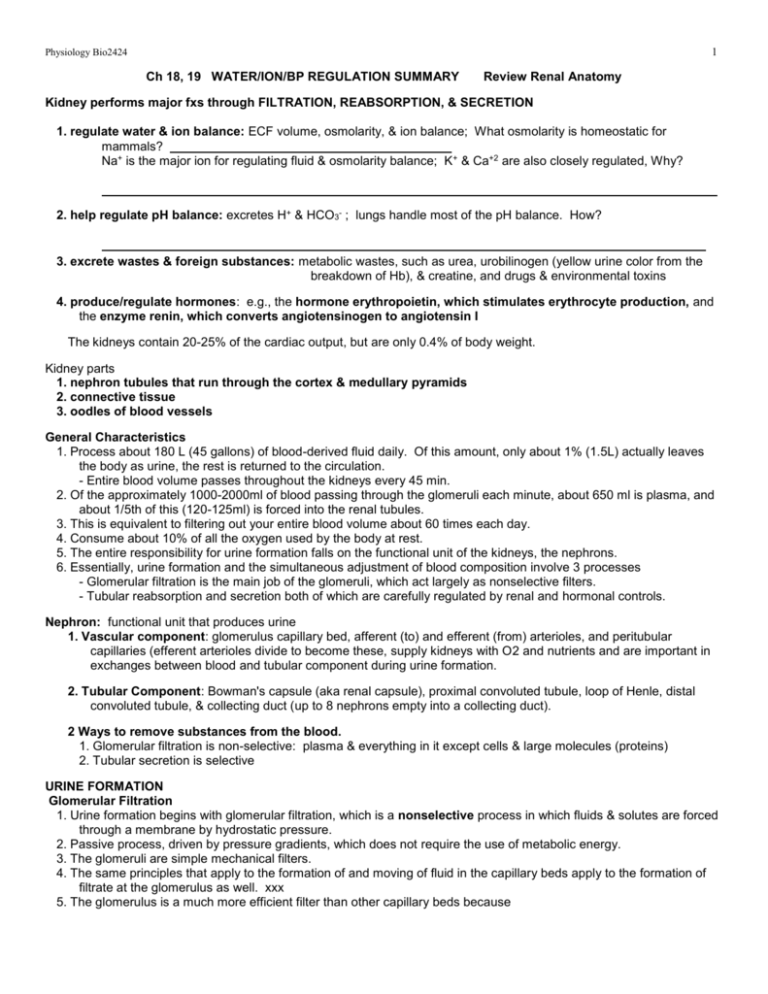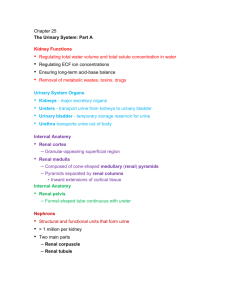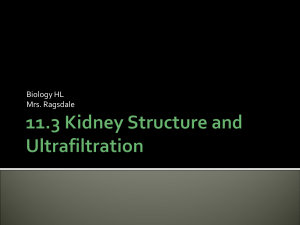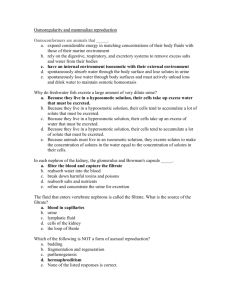KIDNEY FUNCTION - Angelo State University
advertisement

1 Physiology Bio2424 Ch 18, 19 WATER/ION/BP REGULATION SUMMARY Review Renal Anatomy Kidney performs major fxs through FILTRATION, REABSORPTION, & SECRETION 1. regulate water & ion balance: ECF volume, osmolarity, & ion balance; What osmolarity is homeostatic for mammals? Na+ is the major ion for regulating fluid & osmolarity balance; K+ & Ca+2 are also closely regulated, Why? 2. help regulate pH balance: excretes H+ & HCO3- ; lungs handle most of the pH balance. How? 3. excrete wastes & foreign substances: metabolic wastes, such as urea, urobilinogen (yellow urine color from the breakdown of Hb), & creatine, and drugs & environmental toxins 4. produce/regulate hormones: e.g., the hormone erythropoietin, which stimulates erythrocyte production, and the enzyme renin, which converts angiotensinogen to angiotensin I The kidneys contain 20-25% of the cardiac output, but are only 0.4% of body weight. Kidney parts 1. nephron tubules that run through the cortex & medullary pyramids 2. connective tissue 3. oodles of blood vessels General Characteristics 1. Process about 180 L (45 gallons) of blood-derived fluid daily. Of this amount, only about 1% (1.5L) actually leaves the body as urine, the rest is returned to the circulation. - Entire blood volume passes throughout the kidneys every 45 min. 2. Of the approximately 1000-2000ml of blood passing through the glomeruli each minute, about 650 ml is plasma, and about 1/5th of this (120-125ml) is forced into the renal tubules. 3. This is equivalent to filtering out your entire blood volume about 60 times each day. 4. Consume about 10% of all the oxygen used by the body at rest. 5. The entire responsibility for urine formation falls on the functional unit of the kidneys, the nephrons. 6. Essentially, urine formation and the simultaneous adjustment of blood composition involve 3 processes - Glomerular filtration is the main job of the glomeruli, which act largely as nonselective filters. - Tubular reabsorption and secretion both of which are carefully regulated by renal and hormonal controls. Nephron: functional unit that produces urine 1. Vascular component: glomerulus capillary bed, afferent (to) and efferent (from) arterioles, and peritubular capillaries (efferent arterioles divide to become these, supply kidneys with O2 and nutrients and are important in exchanges between blood and tubular component during urine formation. 2. Tubular Component: Bowman's capsule (aka renal capsule), proximal convoluted tubule, loop of Henle, distal convoluted tubule, & collecting duct (up to 8 nephrons empty into a collecting duct). 2 Ways to remove substances from the blood. 1. Glomerular filtration is non-selective: plasma & everything in it except cells & large molecules (proteins) 2. Tubular secretion is selective URINE FORMATION Glomerular Filtration 1. Urine formation begins with glomerular filtration, which is a nonselective process in which fluids & solutes are forced through a membrane by hydrostatic pressure. 2. Passive process, driven by pressure gradients, which does not require the use of metabolic energy. 3. The glomeruli are simple mechanical filters. 4. The same principles that apply to the formation of and moving of fluid in the capillary beds apply to the formation of filtrate at the glomerulus as well. xxx 5. The glomerulus is a much more efficient filter than other capillary beds because 2 Physiology Bio2424 - Its filtration membrane is thousands of time more permeable to water and solutes than are other capillary membranes. Special structure allows for this (larger pores 100x more permeable); all substances must move thru the glomerular membrane: plasma & dissolved substances, but no cells or large proteins - Glomerular BP is much higher than that of other capillary beds (about 55mmHg as opposed to 15-35mmHg) - The high pressure results because the glomeruli are fed and drained by arterioles, and the afferent arterioles are larger in diameter than the efferent arterioles, and the incoming pressure from the renal Aa is high—they branch directly off the abdominal aorta - As a result of these differences, renal corpuscles produce about 180L of filtrate daily (125 ml/min), in contrast to the 3L formed daily by all other capillary beds of the body. - We need to reclaim almost all of this filtrate—How? Tubular Reabsorption 1. Filtrate & urine are quite different - Filtrate contains everything that blood plasma does except large proteins and cells, but by the time filtrate has percolated into the collecting ducts, it has lost most of its water, nutrients, & essential ions. - What remains, now called urine, contains mostly metabolic wastes & unneeded substances in water. 2. Because the total blood volume filters into the renal tubules every 45 minutes or so, all the plasma would be drained away as urine within an hour were it not for the fact that most of the tubule contents are quickly reclaimed & returned to the blood. [ Whew!! ] 3. This reclamation process, called tubular reabsorption, begins as soon as the filtrate enters the proximal convoluted tubules and involves both active & passive transport. - Reabsorbed substances include nutrients, electrolytes, & water. - Must be transferred from the tube to the peritubular capillaries (& vasa recta). 4. Unwanted substances are eliminated in the urine 5. Tubes have increased reabsorption for substances needed by the body, and decreased reabsorption for substances not needed. - 99% of H20 (sounds very efficient, but human kidneys are not particularly efficient compared to some other mammals) - 100% of glucose—What’s the renal threshold? - 99.5% NaCl - 50% of urea (nitrogenous waste product that’s toxic only at high levels) - 0% phenol (toxic waste product) 6. It involves movement through the cells of the tube itself, and the cells of the capillary wall = highly selective Tubular Secretion - 2nd method of eliminating unwanted materials - involves the selective transfer of substances from the peritubular capillaries into the tubular portion (opposite direction of reabsorption). - requires ATP CONTROL OF RENAL FX 1. ANS - controls vasoconstriction, vasodilation - baroreceptor reflex, blood volume - Cardiac Output & Total Peripheral Resistance 2. Hormones - the Renin-Angiotensin-Aldosterone system - Antidiuretic hormone (aka vasopressin) Water & Sodium Regulation 1. Although about 180L of glomerular filtrate are produced/day, the kidneys normally excrete 1-2L 2. Approximately 99% of the filtrate must thus be returned to the vascular system, while 1% is excreted in the urine. 3. The urine volume however, varies according to the needs of the body. [ Is the needs of the one more important than the needs of the many? ] - When a well hydrated person drinks a liter or more of water, urine volume increases to 16ml/min (the equivalent of 23L/day if this were to continue for 24 hours). - In severe dehydration, when the body needs to conserve water, only 0.3ml of urine/min or 400 ml/day are produced - A volume of 400ml/day is needed to excrete the amount of metabolic wastes produced by the body; this is called the obligatory water loss. - When water in excess of this amount is excreted, the urine volume increases & its concentration is decreased. 4. Regardless of the body's hydration state, it is clear that most of the filtered water must be returned to the vascular system to maintain blood volume & pressure. Physiology Bio2424 3 - The return of filtered molecules from the tubules to the blood is called reabsorption. - It is important to realize that the transport of water always occurs passively by osmosis; there is no such thing as active transport of water. The body moves salt to move water through osmosis—remember how water is reabsorbed in the intestinal tract? - A concentration gradient must thus be created between the tubular fluid & blood that favors the osmotic return of water to the vascular system. No such thing as a water pump in organisms = must use an osmotic [ ] to move water Overview 1. Most of the salt and water filtered from the blood is reabsorbed across the wall of the proximal tubule. 2. The reabsorption of water occurs by osmosis, in which water follows the active extrusion of NaCl from the tubule & into the surrounding peritubular capillaries. - Most of the remaining water in the filtrate is reabsorbed across the wall of the collecting duct in the renal medulla (ADH acts here). - This occurs as a result of the high osmotic pressure of the surrounding tissue fluid, which is produced by transport processes in the loop of Henle (i.e., make the renal interstitial fluid salty). Regulation of Sodium 1. Na is reabsorbed, 80% of kidneys energy is used for Na+ transport. 2. Reabsorbed throughout the tube in different degrees. - 67% in proximal convoluted tubule; also aids in reabsorption of glucose, amino acids, water, chloride, & urea. - 25% in loop of Henle plays a role in the production of urine of varying concentrations - 8% in distal convoluted tubule under hormonal control = renin-angiotensin-aldosterone system 3. Reabsorbed by active transport Regulation of H2O Reabsorbed passively (OSMOSIS) by the proximal convoluted tubule, loop of Henle, distal convoluted tubule, & collecting duct. Proximal Convoluted Tubule 1. 67% of the Na is reabsorbed by proximal convoluted tubule active transport. 2. Na is actively transported across the membrane to the interstitial fluid, and is then reabsorbed by the peritubular capillary. 3. This sets up an electrical [ ], which favors the passive transport of Cl- toward the higher, positive Na+ concentration in the interstitial fluid. 4. Sets up an osmotic gradient (hypertonic in interstitial fluid). Water moves by osmosis from the tubular fluid into the epithelial cells into the tissue fluid. 5. The NaCl & water that were reabsorbed from the tubular fluid can then move passively into the surrounding peritubular capillaries. 6. Since 85% of the original glomerular filtrate is immediately reabsorbed in the proximal regions of the nephron (proximal convoluted tubule & loop of Henle), only 15% of the initial filtrate remains to enter the distal convoluted tubule & collecting duct. - This is still a large volume of water (27L/day) that must be reabsorbed to varying degrees, depending on the body's current state of hydration. Remember that 1. Urine is produced at about 1ml/min - 125ml plasma/min is filtered - Must reabsorb 124ml/min - Also must be a mechanism to excrete urine of different concentrations 2. So, how do we move water? - we can’t move water directly, but we can move salt to change the [ ] of water & then rely on the passive process of osmosis - the primary ion moved is Na+, and pumping Na+ is an active process (it’s gonna cost ya) - recall how the small & large intestine reclaims all those 8-9 liters of water secreted into the lumen? Physiology Bio2424 4 Loop of Henle & the Counter-Current Multiplier System - Water cannot be actively transported across the tubule wall and osmosis of water cannot occur if the tubular fluid & surrounding tissue fluid are isotonic to each other. - In order for water to be reabsorbed by osmosis, the surrounding tissue fluid must be hypertonic. - The osmotic pressure of the tissue fluid in the renal medulla is, in fact , raised to over 4X that of the plasma. - The loop of Henle sets up a [ ] in the kidney, so water moves passively by osmosis, and the collecting duct uses this [ ] to excrete urine of varying volume & specific gravity. How establish a [ ] ? = Characteristics of Loop of Henle Descending Limb of the Loop of Henle 1. The descending limb does not actively transport salt, and indeed is believed to be impermeable to the passive diffusion of salt. 2. But it is permeable to water. - Since the surrounding interstitial fluid is hypertonic to the filtrate in the descending limb, water is drawn out of the descending limb by osmosis and enters blood capillaries. The concentration of tubular fluid is thus increased, and its volume decreased, as it descends toward the tip of the Loop. - Filtrate goes from about 300mOsm to 1400mOsm due to the increased permeability of H 2O, which diffuses out of the tubules. Ascending Limb of the Loop of Henle - Filtrate that "rounds the bend" at the tip of the loop has the same osmolality as that of the surrounding tissue fluid (1,200-1,400 mOsm). - Salt transport by the ascending limb is increased accordingly, so that the "saltiness" of the tissue fluid is multiplied. - Since the epithelial cells of the ascending limb are not permeable to water, the tubular fluid becomes increasingly dilute as it ascends towards the cortex, whereas the interstitial fluid surrounding the loops of Henle in the medulla becomes increasingly more salty. - By means of these processes, the tubular fluid that enters the distal tubule in the cortex is made hypotonic (with a concentration of about 100 mOsm), whereas the tissue fluid in the medulla is made hypertonic. Countercurrent Multiplication (flow in opposite directions in a positive feedback loop) 1. The [ Na ] of the interstitial fluid reflects the [ Na ] of the filtrate. 2. Since the [interstitial fluid ] is raised by the active transport of salt from the ascending limb, a positive feedback loop mechanism is created. 3. The more salt the ascending limb transports, the more concentrated will be the fluid that is delivered to it from the descending limb. - This positive feedback mechanism multiplies the concentration of interstitial fluid and descending limb filtrate, and is called the countercurrent multiplier system. - This system recycles salt, transporting much of it from the ascending limb of the loop of Henle into the interstitial fluid of the renal medulla - Results in a gradually increasing concentration of renal tissue fluid from the cortex to the inner medulla; the osmolality increases from 300mOsm (isotonic) in the cortex to 1,200-1,400mOsm in the deepest medulla Distal Convoluted Tubule 1. Na is further regulated by the activity of the renin-angiotensin-aldosterone system—see text p 582. 2. Decrease in BP caused by decrease in Na enzyme renin is secreted from granular cells in afferent arteriole renin activates angiotensinogen (from liver) to angiotensin I in circulatory system ACE enzyme (angiotensin converting enzyme) of the endothelium converts angiotensin I to angiotensin II angiotensin II stimulates adrenal glands to produce & secrete aldosterone increases Na reabsorption in distal convoluted tubule & collecting duct raises level of Na in ECF, then in plasma, & increases BP - Angiotensin II also controls BP by causing vasoconstriction & increasing cardiac output, as well as increasing thirst 3. Opposite when [ Na ] is increased & BP is increased. 4. overactivity of this system can cause hypertension—too much Na reabsorbed. Physiology Bio2424 5 Water Regulation 1. So the loop of Henle & distal convoluted tubule produce filtrate that’s hypotonic to bodily fluids. (This is necessary if you drink a lot of fluids). 2. But we can use this [ ] to concentrate the urine (reabsorb more water) as it moves through the collecting duct. - By changing the collecting ducts permeability to H2O. - This is controlled by the ADH (antidiuretic hormone, aka vasopressin) = absorb more water. ADH Control 1. Is stimulated to be produced & released by anterior pituitary when a H2O deficiency exists. 2. ADH secretion increases the permeability of the collecting duct to water H2O moves out of the collecting duct by osmosis due to salty [ ] urine output decreases - possible to concentrate urine to 1200mOsm, which decreases urine volume. - ADH will not halt urine production totally, but can slow it to .3ml/min about 0.4 to 0.5 L/day obligate water loss. - can vary urine concentration from 100 mOsm (hypotonic) to 1200 mOsm (hypertonic) according to the body's needs 3. Whatever is left in the collecting duct is the urine that’s excreted. Urine Secretion 1. From collecting duct papillae of renal pyramids calyces renal pelvis ureter bladder urethra - Movement through ureter is by peristalsis. 2. The urinary bladder is highly distensible (walnut to grapefruit size), constant urination is prevented by the urethral sphincter which remains contracted. What type of epithelium lines the renal pelvis, ureter, bladder, & proximal urethra? 3. Micturition aided by smooth muscle contraction of the bladder & intra-abdominal pressure. Micturition Reflex - reflex arc begins when bladder stretch receptors provide enough stimulation to the parasympathetic preganglionic motor neurons; about 200ml in the bladder stimulates the stretch receptors 1. Bladder expands with urine & stretch receptors are stimulated 2. Afferent impulse signals the efferent motor neuron that stimulates sustained bladder muscle contraction 3. Afferent impulse also goes to interneuron that signals thalamus; thalamus relays signal to cerebral cortex 4. Urination does not occur until the voluntary external urethral sphincter relaxes, which stimulates the involuntary internal urethral sphincter: IPSP's (inhibitory postsynaptic potentials) are sent to the dendrites of the postganglionic neuron, which stops contraction of the involuntary internal urethral sphincter muscle. 5. If the external urethral sphincter does not relax, the bladder will relax, and as it fills up more, the reflex cycle starts over within the hour (or sooner!!!!!!) 6. Once 500ml is reached, enough pressure may be built up to override voluntary control & open the internal urethral sphincter, which relaxes the external urethral sphincter despite the situation [ Infants lack micturition control because the corticospinal connections aren’t established. Toilet training before 2 typically involves training the parent to anticipate the timing of the reflex, rather than a child’s conscious control. Excretion by the kidney starts about the 9th week of fetal life & is continuous. Urine has been detected in the amniotic fluid as early as 10 weeks. Urine is present in the bladder at birth, but in small quantity, and little is secreted the 2-3 days after birth. ]







